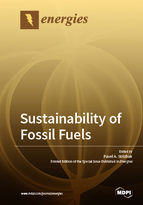Sustainability of Fossil Fuels
A special issue of Energies (ISSN 1996-1073). This special issue belongs to the section "L: Energy Sources".
Deadline for manuscript submissions: closed (31 January 2019) | Viewed by 54882
Special Issue Editor
Interests: energy; fuels; ignition; combustion chemistry; environmental performance; gas emissions; waste-derived fuels; coal–water slurry; waste to energy; thermal engineering; mathematical modeling; heat and mass transfer
Special Issues, Collections and Topics in MDPI journals
Special Issue Information
Dear Colleagues,
The energy and fuel industries represent an extensive field for the development and implementation of solutions aimed at improving the technological, environmental, and economic performance of technological cycles. In recent years, issues of ecology and energy security have become especially important. Energy is firmly connected with all spheres of human economic life, but, unfortunately, it has an extremely negative (often fatal) effect on the environment and public health. Depletion of energy resources, the complexity of their extraction and transportation are also problems of a global scale. Therefore, nowadays it is especially important to try to take care of nature and think about the resources that are necessary for future generations. For scientific teams in different countries, the development of sustainable and safe technologies for the use of fuels in the energy sector will be a challenge in the coming decades.
In this Special Issue, we will try to provide readers with the results of fundamental and applied research and reviews in the field of energy production from the combustion of fossil fuels (coal, peat, oil), waste-derived fuels and biomass.
We are pleased to invite researchers to contribute to the creation of a Special Issue dedicated to various aspects of sustainable use of fossil fuels, biomass, and waste-derived fuels.
Prof. Pavel A. Strizhak
Guest Editor
Manuscript Submission Information
Manuscripts should be submitted online at www.mdpi.com by registering and logging in to this website. Once you are registered, click here to go to the submission form. Manuscripts can be submitted until the deadline. All submissions that pass pre-check are peer-reviewed. Accepted papers will be published continuously in the journal (as soon as accepted) and will be listed together on the special issue website. Research articles, review articles as well as short communications are invited. For planned papers, a title and short abstract (about 100 words) can be sent to the Editorial Office for announcement on this website.
Submitted manuscripts should not have been published previously, nor be under consideration for publication elsewhere (except conference proceedings papers). All manuscripts are thoroughly refereed through a single-blind peer-review process. A guide for authors and other relevant information for submission of manuscripts is available on the Instructions for Authors page. Energies is an international peer-reviewed open access semimonthly journal published by MDPI.
Please visit the Instructions for Authors page before submitting a manuscript. The Article Processing Charge (APC) for publication in this open access journal is 2600 CHF (Swiss Francs). Submitted papers should be well formatted and use good English. Authors may use MDPI's English editing service prior to publication or during author revisions.
Keywords
- Waste
- Combustion of solid, liquid and composite fuels
- New technologies of fuel combustion
- Mathematical modeling of fuel combustion
- Properties of fossil fuels, combustible wastes and biomass
- Ecological problems of thermal power industry
- Technical and economic problems of thermal power industry
- Optimal use of energy resources






